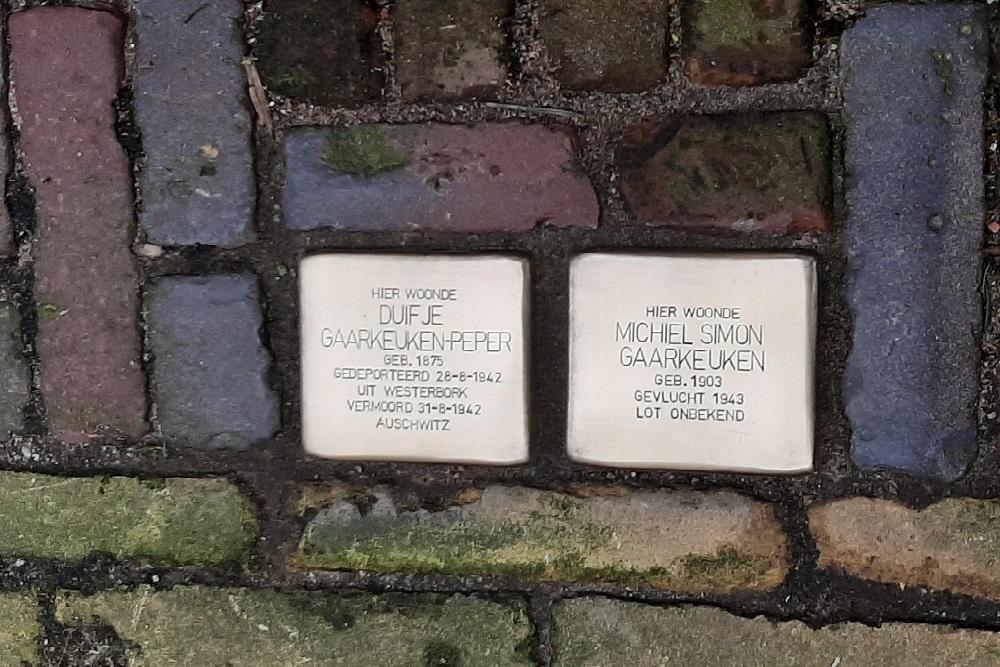Stumbling Stones Oude Raamstraat 11
These memorial stones (so called Stolpersteine of stumbling blocks) commemorate:
family Gaarkeuken
The small copper plaques, in the pavement in front of houses of which the (mostly Jewish) residents were murdered by the Nazis, mention the name, date of birth and place (mostly a concentration camp) and date of death.
In many other cities, mainly in Germany but also in other European countries, the memorials also can be found. There are already many thousands of these plaques and their number is still counting. Almost all Stolpersteine are laid by the German artist himself, Gunter Demnig.
DUIFJE GAARKEUKEN-PEPER July 2, 1875 (Amsterdam) - August 31, 1942 (Auschwitz)
Oude Raamstraat 11
Duifje Peper married her cousin Simon Gaarkeuken on June 20, 1900 in Haarlem. He was a merchant. They had two children, of whom the eldest, Elisabeth (12-5-1901), died as a baby of 10 months. Simon Gaarkeuken died on 3 March 1941 (aged 71) and was buried at the Jewish Cemetery in Haarlem.
After the death of her husband, Duifje lived with her unmarried son Michiel at 11 Oude Raamstraat, where she and her son ran a fruit trade. During a raid on August 25, 1942, she was arrested and deported to Westerbork on August 27, 1942.
Transport from Westerbork to Auschwitz 28 August 1942.
Murdered in Auschwitz on August 31, 1942.
She was 67 years old.
MICHIEL SIMON GAARKEUKEN
February 3rd, 1903 (Haarlem) - unknown
OLD RAAM STREET 11
Michiel Simon Gaarkeuken lived with his mother at 11 Oude Raamstraat. He was a market gardener and fruit merchant. With a handcart he crossed Haarlem and the surrounding area to sell oranges. He also sold books from his house, from puzzle books to political brochures.
From an early age, Michiel (nickname Chiel) was active in various social anarchist and anti-militarist organizations. He was also a member of national youth unions for teetotalers, vegetarians, peace activists, the proletarian free body culture and the Verbond Rebellious Youth. He was an ardent writer of articles in the Haarlems Dagblad and De Vrije Socialist about, among other things, the fight against alcohol and nicotine, total abstinence, proletarian youth movements, peace conferences and socialism, too low wages for workers and bad roads in Haarlem. He also gave lectures for the International Anti-Military Association. In the 1930s he took a stand against the rising anti-Semitism in De Vrije Socialist. Because of his political activities and fierce polemics, he was known to the Central Intelligence Service as a revolutionary and 'propagandist International Anti-Military League'.
In order to stay out of the hands of the Germans, Michiel was admitted to the Provincial Hospital in Santpoort on August 7, 1942. There were more Jewish people in hiding. On January 4, 1943, the evacuation of the hospital began. When the patients and staff were forced to evacuate to other institutions, Michiel ran away. On January 16, 1943, he was admitted to the Jewish psychiatric institution 'Het Apeldoornsche Bosch', where his cousin Magiel Gaarkeuken had been cared for since 1919. A few days later, the Apeldoornsche Bosch was forcibly evacuated. All patients and part of the care staff were deported directly to Auschwitz. They were murdered there on January 25, 1943.
It is unknown whether Michiel was part of this direct transport from the Apeldoornsche Bosch to Auschwitz. Perhaps he fled again, when on 20 January 1943 the warning was given that the evacuation was imminent. From that moment on there is no trace of him.
Missing in the Shoah
He was about 40 years old
Do you have more information about this location? Inform us!
Source
- Text: Reini Elkerbout
- Photos: Reini Elkerbout
Nearby
Museum
Point of interest
- Office Heerbankwartier II WA - Haarlem
- Regional Quarter Nationale Jeugdstorm - Haarlem
- NSB Office Haarlem - Haarlem
Monument
- Memorial Bookstore W.F. van Halst - Haarlem
- Memorial Old Bavo School - Haarlem
- Memorial Execution 7 March 1945 - Haarlem
Cemetery
- Dutch War Graves General Cemetery Kleverlaan - Haarlem
- Commonwealth War Grave General Cemetery Kleverlaan - Haarlem
- Dutch War Graves Roman Catholic Cemetery St. Barbara - Haarlem
Remembrance Stone
- Stumbling Stones Tempeliersstraat 19 - Haarlem
- Stumbling Stones Lorentzplein 11 - Haarlem
- Stumbling Stones Wilhelminastraat 50 - Haarlem
Fortification
- FLAK Stand Haarlem - Haarlem
- Fort Penningsveer - Haarlemmerliede
- Atlantikwall - Regelbau 610 - Bloemendaal





